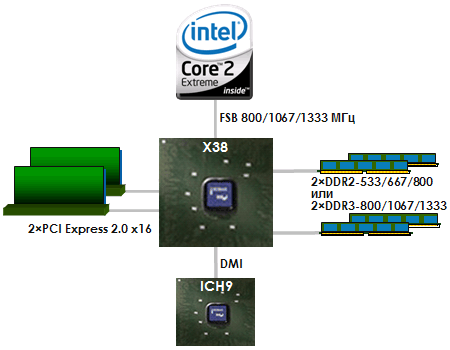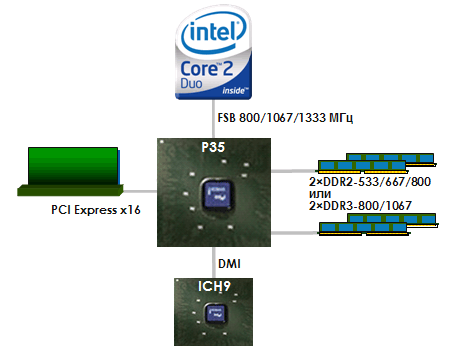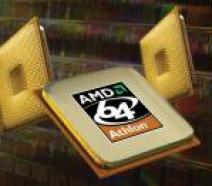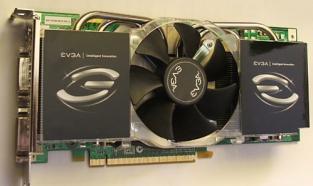MSI P35 NEO COMBO REVIEW P35 VS OTHER CHIPSET BENCHMARK
![]()
|
|
 |
||||||||||||
| Posted:2007-05-27 By chipset review Number of View:32547 |
|||||||||||||
By :chipset review Posted:2007-05-27
Intel corporation almost three years after the release of revolutionary series i9xx released new chipset. Let us recall, that i9xx chipset added new future to desktop systems : new socket type and new power management , DDR2 memory , PCI express system bus and high definition audio. Now we meet the new chipsets generation , which, together with radical numeration change , proposes important architectural characteristics update such as as system bus and memory type . Intel x38 expressTo begin this review we had to start from new top end representative, witch will be released only in the third quarter as entire second new chipsets wave . Earlier the number of top-end model was assigned by the increased numerical index (i915 , i925 , i965 ...), now top product has the (X) prefix . Here is the x38 characteristics :  Let us briefly transfer the fundamental functional characteristics of north bridge used in this chipset:
Processors Support . Here immediately we should specify that officially all chipsets 3x do not support processors celeron D, Pentium 4 and Pentium D (or their versions extreme edition). The absence of support is not due to the changed system bus processor characteristics , but by the new standard FMB motherboard (the processor power module VRM), which provides support of future processors, created according to 45-nm technical process standards , instead of old, produced on base 90nm . Certainly, there is no direct connection between the used chipset and power system on motherboard, but producers, in the majority of cases, follow intel development standards . X38 chipset will officially support all current and future models core 2 Duo, Core 2 Quad and Core 2 Extreme (including four core processor versions), moreover it will support 1333 MHz system bus . Memory Support . The DDR2 controller possibilities in all new chipsets did not change , but here Intel 3x can work also with DDR3 memory . Special features and theoretical performance of new memory type are already checked in our site u can check for example : DDR 3 review or Intel p35 review . DDR3 will present some advantage : less heat emission (DDR 3-1066 supply voltage will be lowered, even less than DDR 2-800). DDR3 are assumed to reach the frequencies 800 (1600) MHz, But X38 as start support the highest-speed version available DDR 3-1333. DDR3 Modules has not reached the mass production step , But elite producers (like Corsair) will make high frequency DDR3 memory soon with high price . To all our readers we recommend to wait, since the DDR3 prices will be lowered over time and characteristics will grow up. According to analysts forecast , the release of DDR3 will reach 50% of the market only in 2009, and to the end of 2007 this memory type will hardly collect 10%. PCI express 2.0. Here Intel finally delivers chipset with support of two interfaces PCI express x16 , using second version host-controller .The application OF PCI express 2.0 will not interfere with old video card, since connector is the same, and compatibility in both sides is preserved. The PCI express 2.0 update is not too interesting, we have two exception here : the first, twice increased performance of each channel (line) PCI express, one channel (PCIE 1x) now has capacity 500 MB/s to each side simultaneously, and the capacity will be 16 GB/s. in Second place , two time increased power on the system bus : the slot PCIEx16 in the first version ensure up to 75 W, now video card can obtain 150 W. X38 is also paired with new south bridge family ICH9, we will examine its functionality in detail later on this review. Intel p35 expressThis Chipset belong to the category performance, and has the following architecture:  Let us briefly transfer the fundamental functional characteristics of north bridge used in this chipset:
Here the update quantity is a little less. The support of processors is limited by the same models 65-nm and future 45-nm technical process. This chipset is deprived from support to DDR 3 memory -1333MHZ . Instead of PCI express 2.0 here intel used the standard graphic interface PCI express x16 (first version), and as P965 and earlier chipsets, P35 does not allow to flexibly configure this interface for crossfire support . However, as earlier, Main-board producers create solution with p35 and Crossfire, connecting the second slot to the south bridge . Intel g33 expressBasic integrated chipset in this new family will get the name : G33, with functionality on the P35 level . In the third quarter , intel will release one additional integrated chipset (the so-called G35), with improved graphic core. Thus, G33, is the p35 version with integrated graphic core and has the following architecture:  Let us briefly transfer the fundamental functional characteristics of north bridge in this chipset:
From G33 characteristics , its cleat that this last repeated P35 : The only difference is the built-in card. Built-in Video core GMA x3100. We hope that X3100 video core will be finished rapidly, and we will finally see everything that was promised in x3000 (G965). In essence, this new video core will not bring serious changes, differences we became clear only after tests :-). Let us recall that technology clear video is called by hardware to accelerate and to improve the image quality (colors correction) for video content (including HD), and also digital video interface (including HDMI). Intel g31, G35, Q35 expressThose are the remaining chipsets, planed for release in the third quarter 2007. G31 : integrated chipset (initial level). Its functionality is located on 945G level . Even south bridge in this chipset use the same old ICH7/R . G31 support core 2 Duo (but with FSB frequency not above 1066 MHz) and memory up to DDR 2-800. G35 : interesting integrated chipset with optimized graphic engine, as Intel promises , this last will become the first integrated solution with directX 10 support . G35 promises to be similar to G965, it will bring the support to 45-nm Wolfdale and Yorkfield and new Core 2 Duo with 1333 MHz FSB frequency (DDR3 memory is not supported). As south bridge, G35 will use the old ICH8/R/DH. Q35 (and its simplified version q33) : base for business- systems intel vPro, integrated chipset with some gaming possibilities. Most interesting , that the combination q35 with south bridge ICH9DO (Digital office), will ensure support to technologies such as AMT (Active management technology) 3.0, Trusted execution technology and Virtualization technology. Q35 also will not support DDR3 memory . South bridges intel ICH9The new chipsets has the updated south bridges. ICH9 has a number of evolutionary improvements in comparison with ICH8. Let us briefly transfer the fundamental functional characteristics of this new south bridges:
ICH9R differed from ICH9 in terms of presence to RAID support , and also in terms of two additional SATA ports . The special versions south bridge ICH9DO (Digital office) and ICH9DH (Digital home) are based on ICH9R, but the first proposes additionally the function active management technology 3.0, Trusted execution technology and Virtualization technology, and the second present viiv technology only. From the insignificant changes it is possible to note the increased to 12 number of USB 2.0 ports , the realization of function eSATA and also SATA now. As Alternative to RAID , for data safety , Intel added the new technology intel rapid recover , which allow to create a clone disk , rapid update, without touching unchanged files, and to rapidly restore data if the first disk is damaged . In the south bridge as before we have the integrated MAC- controller gigabit Ethernet. The new south bridges bring the support to technology intel turbo memory (in development process this last was known as : robson technology). This last consist on module with a certain volume NAND-flash- memory (512 MB and 1 GB) integrated in main-board . Apparently, this module will be installed in PCIE 1x slot , But they are possible in different connection versions . Gain from Turbo memory will obtain Windows vista users.. Briefly, in the first case we obtain the possibility to use a flash- disk as HDD cache in linear operations (read- write) , We must not see a large gain from Flash - memory since this last is slower than hard disk, so benefit from Ready-Drive will be observed with regular operations in exchange of small data portions , which are updated frequently (access time in flash- memory is noticeably lower than Hard disk). Additional advantage consists in the reduction of hard disk work which allow to economize electric power , certainly, real gain is only for mobile devices (Notebooks). However, Ready-Boost enlarges the accessible memory volume for data caching (from hard disk), and also propose low random access time witch will help to noticeably accelerate applications load . . Heat emission. let us finally talk about the heat emission in new chipsets. P35 chipset as all other new chipset use the same 90 nm technical process , the chipset series 3x consume noticeably less power than their predecessors: P35 : 14,5 w (P965 : 19 W), G33 : 16 W (G965 : 28 W). Chipset 3x PerformanceSystem Used :
Software:
Test platformToday\'s test will help to answer immediately for two questions. First, we will see what is the speed of DDR2 and DDR3 on (P35) platform , and second, we will compare both versions of this platform with other chipsets. The comparison of two memory types proved to be difficult , since the BIOS versions of our mainboard MSI was not practically ready to DDR3: The p35 neo combo BIOS did not allow to set the normal supply voltage (for DDR3) (1,5 v) and latency (were limited to the standard DDR2, it was not possible to set values higher than 6). In this case the available to us modules corsair in regime DDR 3-1066 did not agree to work with latency below 7- 7-7. In regime DDR 3-1066 (latency by SPD), according to CPU- Z, the latency proved to be the following: 7-7- 7-20. At the same time, at frequency 800 MHz our DDR3 modules unexpectedly easily agreed to work even with latency 4- 4- 4-12 , this will allow to compare this configuration P965 and nForce 680i LT SLI in their standard regime with DDR 2-800@4- 4- 4-12. . Tests ResultsLet us begin from a low-level study for the memory potential with the aid of rightMark memory analyzer. P35, which on data read is noticeably inferior to both competitors, demonstrates an interesting effect: with memory (both DDR2 and DDR3) at frequency 1066 MHz its performance is higher than in regime DDR 2-800, although those value are a little reduced in nForce 680i LT SLI. We note that DDR3 appears noticeably worse than DDR2 even with equal latencies. New chipset is noticeably slower than competitors, DDR3 are slower than DDR2 (especially at 800 MHz frequency ), and passage to 1066 MHz memory frequency accelerates P35 with both memory types , but slows down NVIDIA chipset . Finally, memory latency test , and here the first surprise occurs with p35 memory controller technology, analogous TO DASP in NVIDIA : in reading from memory process (without exceeding the page limits ) latency is lowered radically. Thus, according to real results it is possible note the following conclusions. From one side, P35 a little (now it is possible to say concretely up to 7%) inferior than P965 and nForce 680i LT SLI, DDR 2-800 in P35 is faster than DDR 3-800 with equal latencies , and DDR2/3-1066 in P35 are faster than the same memory type with 800 MHz frequency. From other side, it is worthwhile to note that difference by 7% is observed only in one test, and work with DDR 2-800 is not worse in p35. But we will not hurry with conclusion, let us look to other tests results . No surprises here, as usual, all competitors appear equal, since the performance of processor is the limiting factor. In professional 3d- applications sPECviewperf we can note can only NVIDIA chipsets with its optimized graphic system bus controller , since in different memory operation modes (and even different memory types ) the speed influence is very low . In games we have not get any update , in DOOM 3 the absolute winner is P35 (and certainly, with memory, which works at 1066 MHz frequency ). However, the difference between chipset in Doom 3 is generally small, not more than 3%, but losses with the use OF DDR3 instead DDR2 in P35 is less than 2%. ConclusionsIt is difficult to evaluate chipsets, which introduce immediately several revolutionary update. In this case the announcement came out smooth, PCI express 2.0 will appear only in the third quarter, with x38 release , there is no expected compatibility problem with passage to new version . The second update is the DDR3 memory , so it is possible to wait for prices reduction and increase in characteristics of new memory type . The New south bridge is moderately progressive, its main special feature is Intel Turbo memory, witch needs a practical test before getting conclusion. (This will be the theme in our next reviews ) Before passage to performance estimation , it is desirable to note : first, the speed level confirmation shown by MSI mainboard . Actually, all three motherboard demonstrated absolutely identical performance level with DDR2 (two of them support only this memory type ); Our conclusions are : taking in account all enumerated and implied reservations, new chipset series appear somewhat slower than old (both i965 and NVIDIA nForce 600i), DDR3 memory under equal conditions result in loss about 2-3% performance, and P35 is better suitable for memory, which works at 1066 MHz frequency . This conclusion is valid for P35 mainboard from MSI but our previous review p35 review based on asus and gigabyte show completely a different results...
we would be happy to answer for your question . if you have suggestion or comment
regarding this review our support would be glad to help just join our forum and ask u will get the best answer
to discuss check our forum section :-) RATE THIS REVIEW | |||||||||||||
![]()

MSI P35 Neo Combo review p35 vs other chipset benchmark
MSI P35 Neo Combo review p35 vs other chipset benchmark


7600gt review
7600gt is the middle card range.
We already benchmarked this video card and found that ...

 geforce 8800gtx and 8800gts
geforce 8800gtx and 8800gts  Xtreview software download Section
Xtreview software download Section  AMD TURION 64 X2 REVIEW
AMD TURION 64 X2 REVIEW  INTEL PENTIUM D 920 , INTEL PENTIUM D 930
INTEL PENTIUM D 920 , INTEL PENTIUM D 930  6800XT REVIEW
6800XT REVIEW  computer hardware REVIEW
computer hardware REVIEW  INTEL CONROE CORE DUO 2 REVIEW VS AMD AM2
INTEL CONROE CORE DUO 2 REVIEW VS AMD AM2  INTEL PENTIUM D 805 INTEL D805
INTEL PENTIUM D 805 INTEL D805  Free desktop wallpaper
Free desktop wallpaper  online fighting game
online fighting game  Xtreview price comparison center
Xtreview price comparison center 

- The new version of GPU-Z finally kills the belief in the miracle of Vega transformation
- The motherboard manufacturer confirms the characteristics of the processors Coffee Lake
- We are looking for copper coolers on NVIDIA Volta computing accelerators
- Unofficially about Intels plans to release 300-series chipset
- The Japanese representation of AMD offered monetary compensation to the first buyers of Ryzen Threadripper
- This year will not be released more than 45 million motherboards
- TSMC denies the presentation of charges from the antimonopoly authorities
- Radeon RX Vega 64 at frequencies 1802-1000 MHz updated the record GPUPI 1B
- AMD itself would like to believe that mobile processors Ryzen have already been released
- AMD Vega 20 will find application in accelerating computations
- Pre-orders for new iPhone start next week
- Radeon RX Vega 57, 58 and 59: the wonders of transformation
- ASML starts commercial delivery of EUV-scanners
- The older Skylake processors with a free multiplier are removed from production
- Meizu will release Android-smartphone based on Helio P40
- AMD Bristol Ridge processors are also available in American retail
- The fate of Toshiba Memory can be solved to the next environment
- duo GeForce GTX 1080 Ti in GPUPI 1B at frequencies of 2480-10320 MHz
- New Kentsfield overclocking record up to 5204 MHz
- Lenovo released Android-smartphone K8



computer news computer parts review Old Forum Downloads New Forum Login Join Articles terms Hardware blog Sitemap Get Freebies

